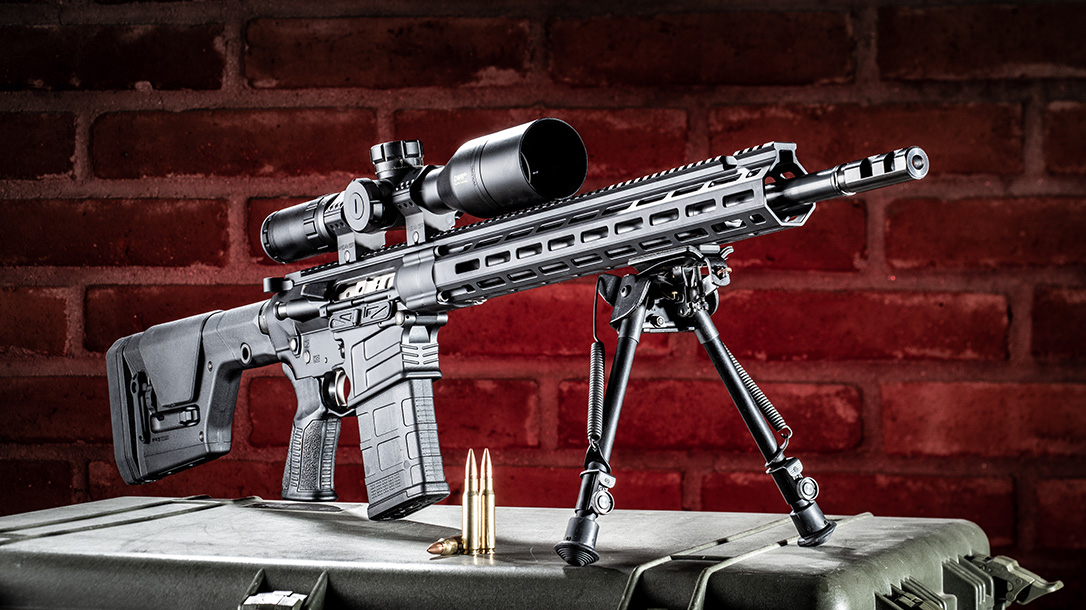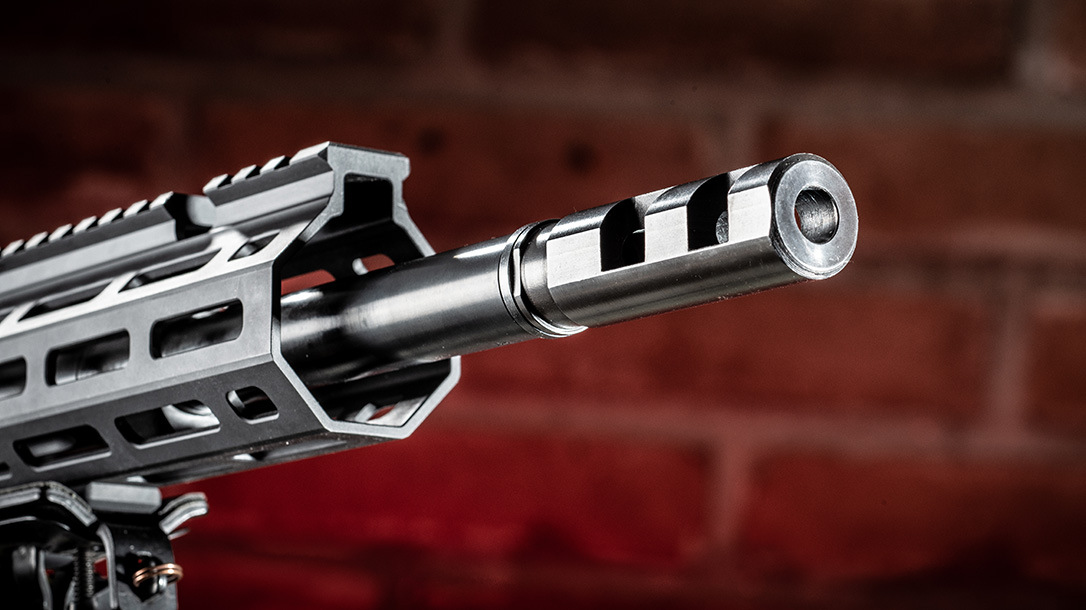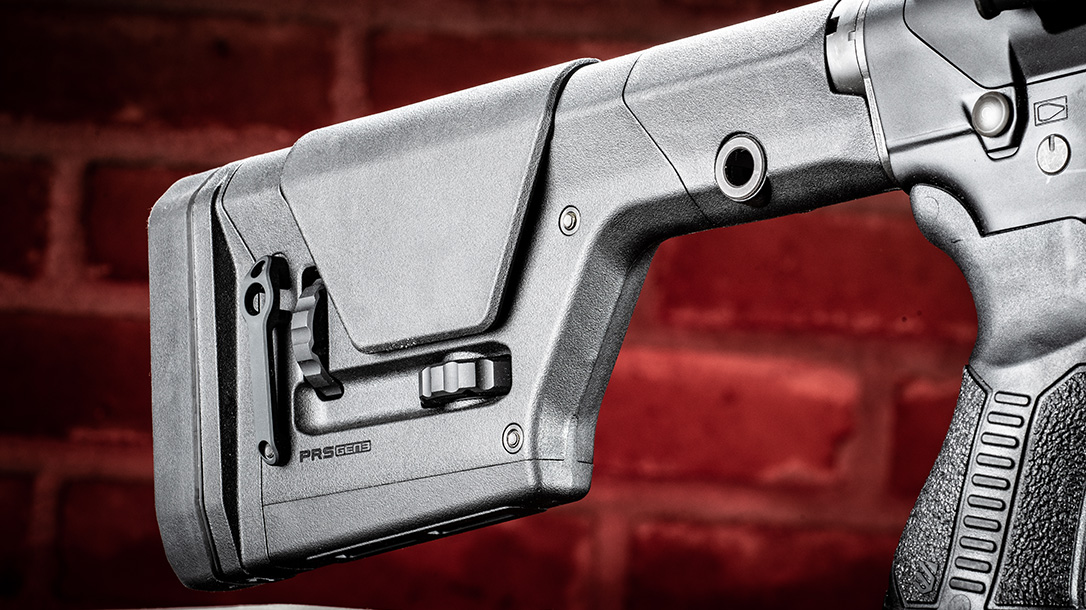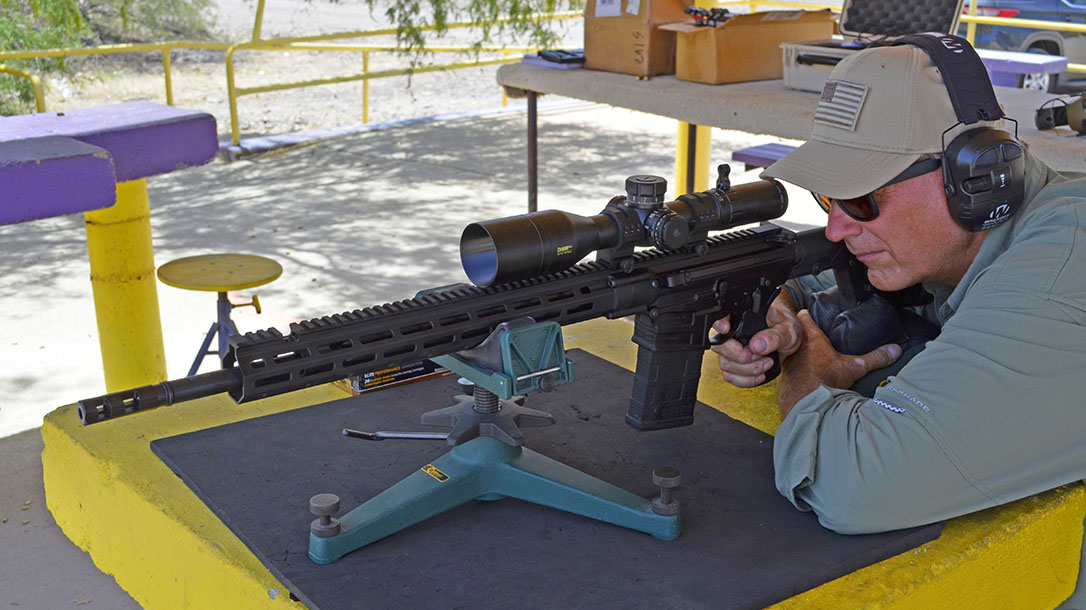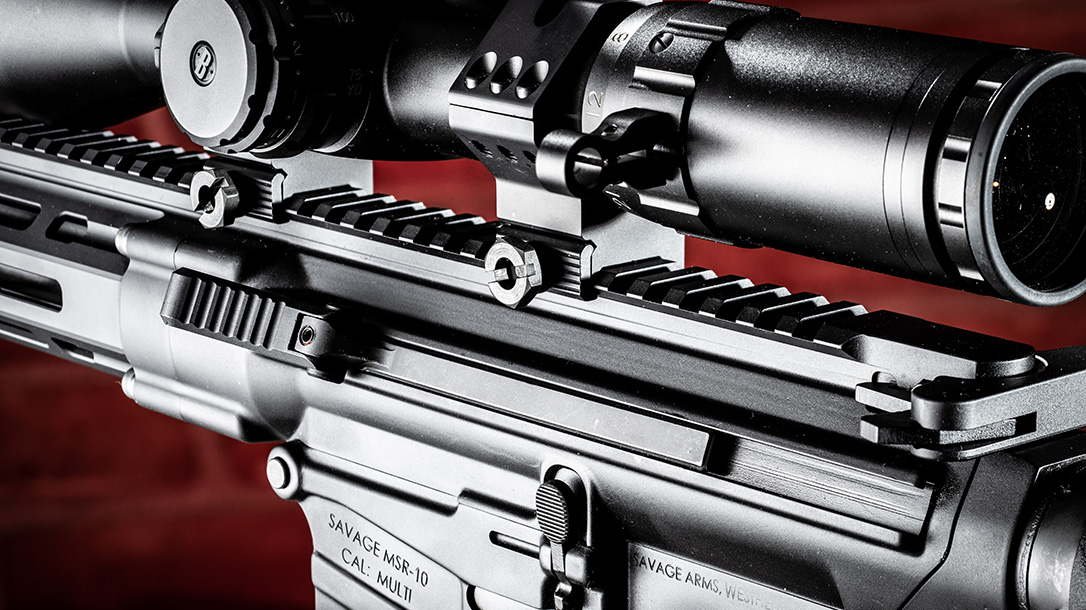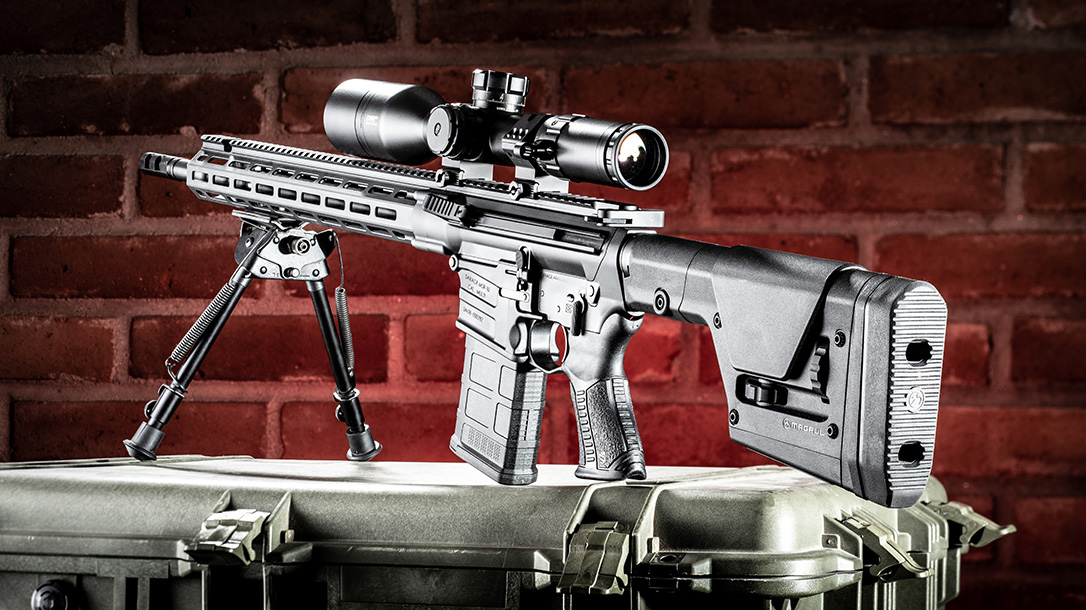Fifteen years ago, no one would seriously consider a semi-auto rifle for precision use. We’d spend thousands of dollars trying to get our bolt guns to break the MOA gold standard. It took a lot of effort—blueprinting the action, glass bedding, high-dollar barrels, adjustable triggers, load development.
But somewhere along the way, we discovered that AR-platform rifles could easily shoot groups under an inch wide without quite so much effort. Softer recoil, quicker follow-up shots and longer service life are some of the other advantages of the AR,or modern sporting rifle (MSR).
Advertisement — Continue Reading Below
Enter Savage Arms
In 2017, Savage Arms began producing its own ARs.
I tested the company’s MSR 15 Recon rifle in 5.56mm NATO and found it to be extremely well built and constructed with the finest materials. The gun was well thought out and assembled with an unusual degree of expertise.
Several months after the MSR 15 series was introduced, Savage began rolling out big-bore MSR 10s, and I recently got my hands on the Savage MSR 10 Long Range in .308 Winchester/ 7.62mm NATO for testing.
Advertisement — Continue Reading Below
Earning Its Name
Designed for precision shooting, the MSR 10 Long Range comes with free-floating, 20-inch barrel, an adjustable gas system and a match-grade, two-stage trigger. The rifle also features a non-reciprocating side charging handle, a Magpul PRS GEN3 adjustable stock and a very effective two-port muzzle brake.
Savage engineers started with a fresh page when they designed the MSR 10. Consider the gas system, for example. The MSR 10 is a direct-impingement gun, but Savage outfits the rifle with a gas tube that measures more than 2 inches longer than a standard rifle-length gas tube. This helps decrease pressure. The action can’t cycle until the projectile passes the barrel’s gas port, and the tube’s longer length provides more volume.
Less chamber pressure means easier extraction of spent cases as well as a weapon that lasts longer. Shooters can also fine-tune the rifle for specific loads by using the adjustable gas block. A properly gassed gun will run longer, softer and better while reducing wear on the gun.
Advertisement — Continue Reading Below
For maximum reliability, Savage designed the bolt to use two spring-loaded, plunger-style ejectors along with a more conventional extractor. The gas key is actually machined into the bolt carrier so you don’t have to worry about it being properly staked. While the bolt has a QPQ finish like the barrel and is serialized to the gun, the bolt carrier body is nickel-boron plated, which adds a degree of lubricity and makes it extremely easy to clean. Also, unlike the AR-15s, the MSR 10 does use a spring-loaded firing pin.
“Compact”
Savage bills the MSR 10 as having a “compact” design, and the upper receiver is shorter by 0.7 inches. The bolt carrier is also shortened and 17-percent lighter. Of course, less reciprocating mass translates to less recoil, and Savage also installs a lighter buffer that, again, helps minimize felt recoil and reduce overall weight.
The 20-inch barrel has 5R rifling, which means it has five lands and grooves that are arranged so they aren’t directly opposite each other, preventing uneven constriction on the projectile. The lands are slightly slanted and less likely to collect bullet jacket material, which should boost accuracy while making the barrel easier to clean. The barrel also has a 1-in-10-inch twist rate and a very effective two-port muzzle brake. I didn’t notice it too much when shooting from a benchrest, but off-hand, I actually found that it was so effective it pushed the muzzle downward.
Advertisement — Continue Reading Below
To protect the barrel from corrosion, Savage treats its interior and exterior with Melonite QPQ. Besides making the barrel harder, it also has a lower friction coefficient than chrome. There are also six heavy flutes on the exterior of the barrel, under the handguard. These flutes help reduce weight without losing an ounce of rigidity.
Surrounding the barrel and gas system is an aluminum handguard with a full-length Picatinny rail on top with an access port machined for the gas block about an inch and a half from its forward edge. You’ll also notice M-LOK slots along the sides and bottom for attaching lights, lasers, bipods, etc. The upper and handguard are mated with four screws.
Receivers
The upper and lower receivers are custom forged. Their stylized lines give the lower a decidedly “billet” look, though it is not. There are grooves on the front of the magazine well for those who like to shoot with their support hand in this location instead of on the handguard. There are also indexing cuts at the rear of the mag well to give shooters a place to index their trigger fingers when not firing, and the lower has an integral, enlarged triggerguard.
Advertisement — Continue Reading Below
One interesting feature of the lower receiver is that Savage has drilled and tapped it for a setscrew that, when tightened, eliminates all of the play between the upper and lower receivers. The tip of the screw bears against the bottom of the rear lug of the upper receiver. The pistol grip must be removed to adjust this screw, but, when properly adjusted, it gives the rifle a decidedly solid feel.
Finally, a precision rifle is only as good as its trigger, and Savage uses a BlackHawk two-stage trigger on the MSR 10 Long Range. The hammer and trigger are nickel-boron treated, increasing the parts’ hardness and making them incredibly slick. My test sample’s trigger broke consistently at 2.5 pounds and had a very firm reset. The trigger isn’t adjustable, though, frankly, I’m not sure there is anything I would change.
Advertisement — Continue Reading Below
Zeroing In
For testing, Bushnell provided me with a 3.5-21x50mm Elite Tactical DMR II-i scope. This optic is capable of providing long-range precision without sacrificing short-range capabilities. The scope’s illumination control is integrated with the side parallax focus in one simple knob for easy adjustability. Bushnell’s ThrowHammer lever also makes magnification changes quick and easy. Weighing in at over 2 pounds, the DMR II-i is no lightweight, but I found this first-focal-plane scope easy to adjust and get on target, and its clear and bright optics made shooting from the bench downright easy.
Most of my shooting locations were shut down here in southeastern Arizona in early June due to fire hazards, so I took the MSR 10 to a public range in Mammoth with a solid backstop, an awning over the shooting positions and concrete benches. I set my Shoot-N-C targets out at 100 yards, and it became immediately clear that my biggest challenge would be keeping sweat out of my eyes long enough to squeeze off a shot as the temperature was about 104 degrees.
Testing the Savage MSR 10 Long Range
One of the things I noted was that the MSR 10 produced nice round groups that didn’t show any evidence of horizontal or vertical stringing. I didn’t let the barrel cool between shots, so it got very hot, yet my groups remained constant. I fired several groups with five different test loads, with the best results shown in the accompanying table (below).
Advertisement — Continue Reading Below
When I fired my first group with Federal’s 175-grain Gold Medal Match BTHPs, I noticed that I could fire one shot before getting a click when attempting the second shot. The rifle’s bolt was short-stroking and not coming back far enough to strip the next round out of the magazine. By turning the adjustment screw on the gas block counterclockwise, I was able to get the MSR 10 to cycle perfectly with the Federal rounds. These rounds also produced a tight five-shot group measuring just 0.89 inches. But the 168-grain Federal rounds printed my tightest group of 0.87 inches. In the end, the Savage proved that it was capable of producing sub-MOA groups with all five of the loads I tested.
One of the most impressive features of the MSR 10 Long Range is just how light it is on recoil. The gun is incredibly easy on the shoulder, and the felt recoil wasn’t what I’m used to with AR-10-style rifles. The MSR 10’s innovative gas system, compact bolt and muzzle brake make a great deal of difference. The light and crisp trigger, with its firm reset, also makes it easy to get back on target quickly for fast follow-up shots.
Final Thoughts
While Savage Arms might be a latecomer to the modern sporting rifle party, its MSR 10 Long Range displays some brilliant and innovative engineering that sets the company apart from all the other “me-too” manufacturers. This rifle is accurate and easily adaptable to different types of ammunition and missions. If you’re looking for a long-range precision rifle, make sure you check it out.
Advertisement — Continue Reading Below
For more information, please visit SavageArms.com.
Savage MSR 10 Long Range Specs
- Caliber: 7.62mm NATO
- Barrel: 20 inches
- OA Length: 40.63-42.63 inches
- Weight: 9.75 pounds (empty)
- Stock: Magpul PRS GEN3
- Sights: None
- Action: Direct impingement semi-auto
- Finish: Matte black
- Capacity: 20+1
- MSRP: $2,284
Savage MSR 10 Long Range Performance
| Load | Velocity | Accuracy |
|---|---|---|
| Black Hills 155 TMK | 2,847 | 0.91 |
| Black Hills 168 BTHP | 2,802 | 0.95 |
| Black Hills 175 BTHP | 2,781 | 0.87 |
| Federal 168 Gold Medal Match BTHP | 2,822 | 0.87 |
| Federal 175 Gold Medal Match BTHP | 2,755 | 0.89 |
*Bullet weight measured in grains; velocity in fps by chronograph; and accuracy in inches for best five-shot groups at 100 yards.*
This article is from the November/December 2018 issue of Tactical Life magazine. Grab your copy at OutdoorGroupStore.com. For digital subscriptions, please visit our Amazon store.
